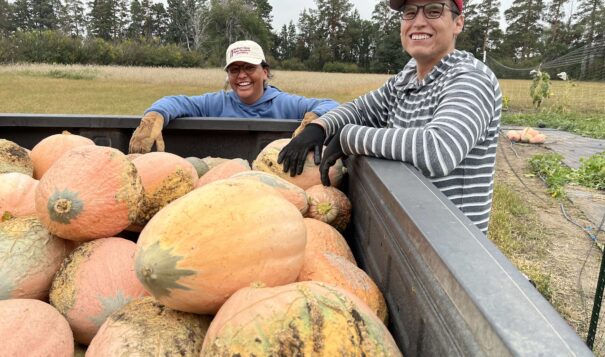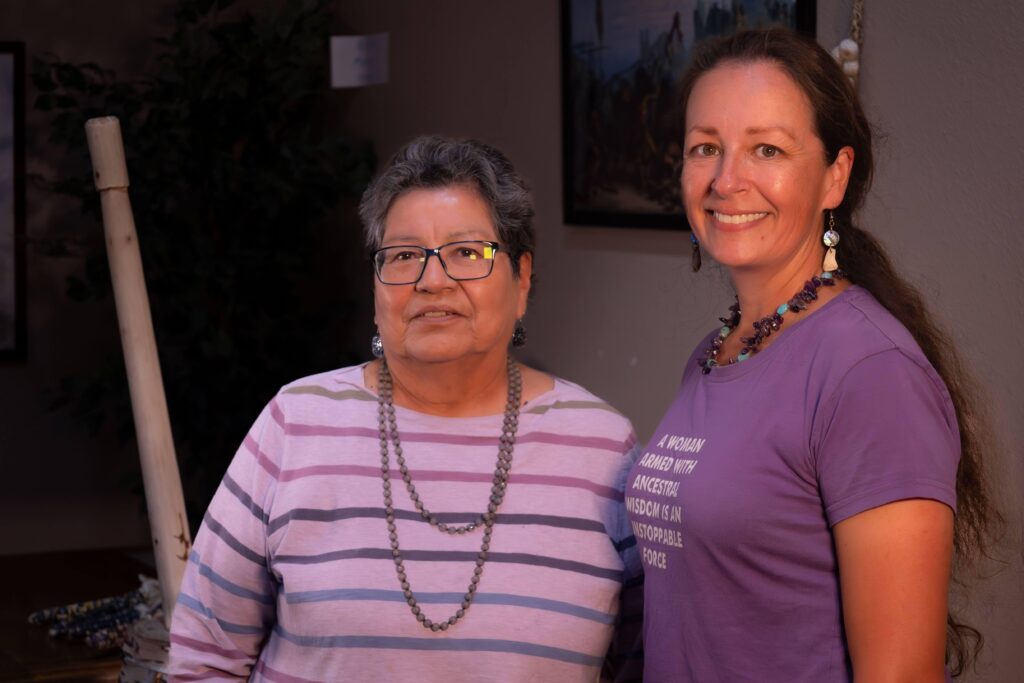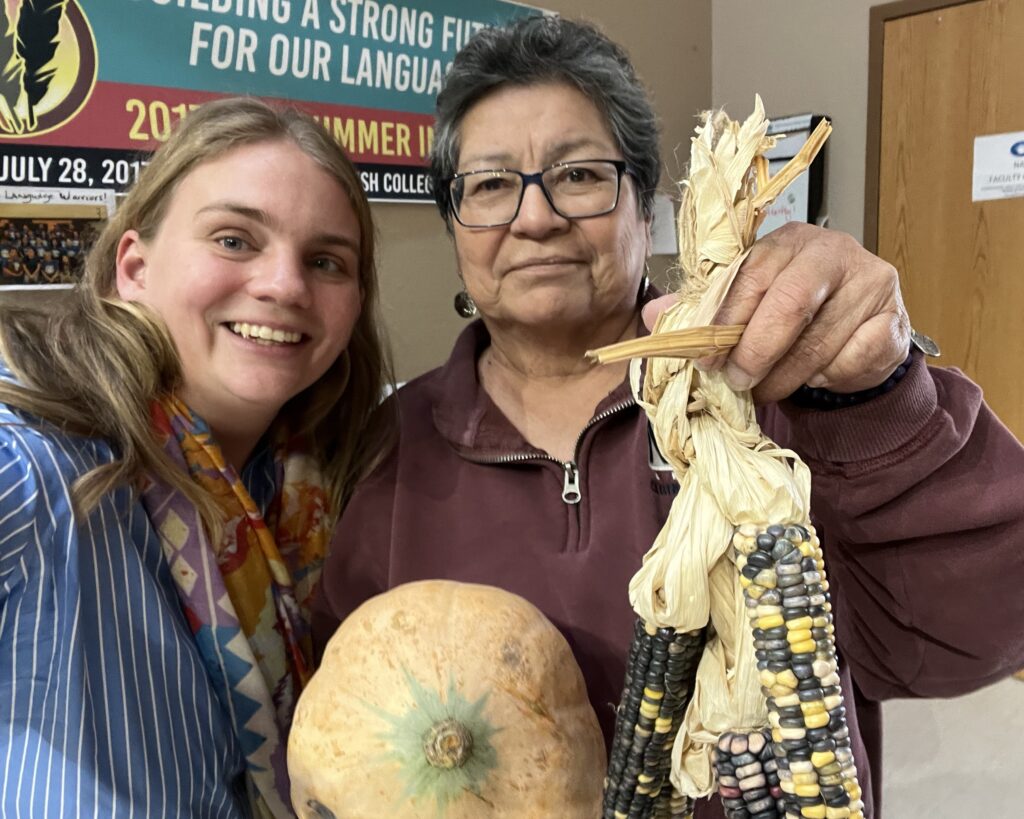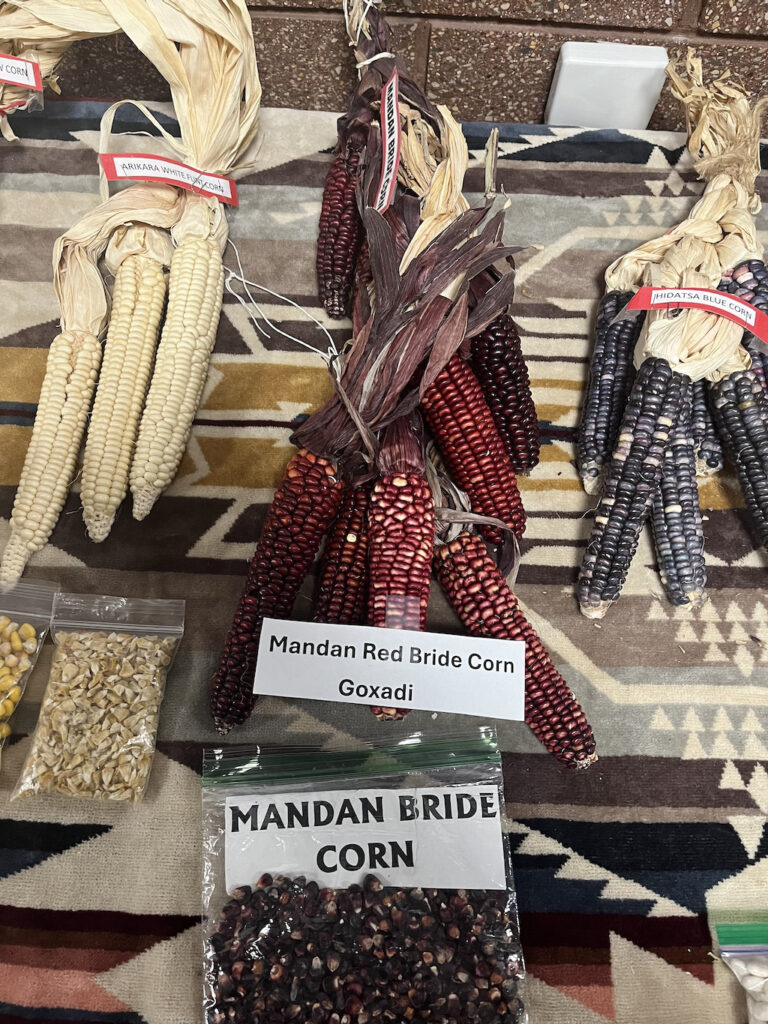Grandfather’s vision about ‘gallons and gallons’ of Mandan, Hidatsa and Arikara seeds nurtures tribal college food sovereignty project.
Dr. Ruth Plenty Sweetgrass-She Kills recalls when her grandfather, Gerard Baker, shared with her some seeds – and his dream that they would multiply. “His wish was that there would be gallons and gallons of jars of these seeds so that community people could have access to them, so that they could be gardening with our traditional seeds,” she said.
Para leer este artículo en Español ir a Sembrando Soberanía: Recuperando la Agricultura Indígena en Dakota del Norte

Plenty Sweetgrass-She Kills is the director of the Food Sovereignty Program at Nueta Hidatsa Sahnish College in New Town, North Dakota. That moment with her grandfather germinated in her mind and took root in her work at the college. She proposed to expand the program’s Traditional Seed Cache and teamed up with Dr. Claire Friedrichsen to secure $100,000 to launch the project.
Friedrichsen, a research social scientist in the Agricultural Research Service at the U.S. Department of Agriculture, explained to Buffalo’s Fire that stored seeds need to be planted at least every decade as their viability decreases by about 10 percent each year.
The ARS operates the Northern Great Plains Research Laboratory (NGPRL), located in the ancestral homeland of the Mandan people on the Heart River near Mandan, North Dakota. It began providing space and resources for the college program in 2023, with funding from USDA’s Office of Tribal Relations.

The project lays the groundwork for ongoing collaboration between the college and the ARS, as part of Agriculture Secretary Tom Vilsack’s special initiative to support Indigenous Traditional Ecological Knowledge, participants stress. “The project is really more than just the seeds; it is about setting a process and relationship in motion to support future research,” said Friedrichsen.
The Four Sisters: Nurturing a time of plenty
For the Mandan, Hidatsa and Arikara people, seeds are even more than miraculous kernels of life. They are relatives and storehouses of ancestral memory, linked back to a time of abundance connected to the land. That is why the seed sovereignty project generates so much excitement throughout the community. Last month, the program’s first Food and Seed Summit drew around 100 enthusiastic participants.
The college’s food sovereignty effort aims to help reverse the cultural loss from the MHA Nation’s 1940s dislocation by flooding from the massive Garrison Dam. The seed sovereignty project engages faculty and community members, elders and USDA researchers to cultivate food security in the Three Affiliated Tribes.
Like others from her community, Plenty Sweetgrass-She Kills grew up hearing the stories about a time of bounty, when the Three Affiliated Tribes farmed the rich bottomlands of the Missouri River. They grew nearly everything they needed in a tight-knit network of communities where work was shared and abundance existed for all.
The stories were all that remained from those days – and the seeds.
“We had a lot of independence, even up to the 1940s,” Plenty Sweetgrass-She Kills told Buffalo’s Fire. “Then, with the Garrison Dam, that had some devastating impacts in terms of our ability to grow our traditional foods.”
The Pick-Sloan Flood Control Act of 1944 destroyed more than 550 square miles of tribal land in North Dakota, South Dakota and Nebraska. It dislocated more than 900 Native families, through dam-building up and down the Missouri River. The Garrison Dam at Fort Berthold Reservation caused the legislation’s most devastating effects on any reservation.

The dam flooded 90 percent of the Three Affiliated Tribes’ agricultural land, and the government relocated most tribal citizens to the arid and much less fertile prairie uplands. A period of harsh poverty ensued. But the impact went far beyond the loss of the land. The other part was the loss of community.
Agriculture “was a community thing, it was a family thing. Part of the food system was that interdependence we had on each other,” said Plenty Sweetgrass-She Kills. “That split caused by the dam had impacts not just on the ecological side of growing food but also the social side.”
MHA Nation citizen Bernadine Young Bird, educator and current keeper of the college’s Native American Studies Department Garden, grew up during that hard time. She and her mother, Martha Fox, planted a garden on the arid prairie each summer, sharing seeds and harvests with family.
“My family had a garden and they did their best with it, but it kind of petered out,” she said. They gradually left aside the family farm life that had once made the tribes known throughout the region for abundant harvests.
Like many in her generation, Young Bird found her path through higher education, becoming a teacher, school administrator, and finally, a faculty member at NHSC.
She works closely with the Food Sovereignty Program, part of the Agricultural Department of NHSC. Her focus will continue to create awareness and enhance the knowledge of traditional seeds and agricultural practices. She studied the work of Buffalo Bird Woman, a traditional Hidatsa whose interviews with ethnographer Gilbert Wilson helped preserve the old ways. Then she followed Buffalo Bird Woman’s teachings, developed over centuries.
She turned to companion planting of the Four Sisters—corn, beans, squash, and sunflowers. Unlike in the modern monoculture system, each of the Four Sisters plays a role in a symbiotic relationship. The squash spreads its vines to maintain ground moisture, while the beans add nitrogen to the soil, which the corn craves. The corn stalks help the bean stems climb toward the sunlight source, and the sunflowers provide a natural shelter belt.

So Young Bird found herself, an elder about the same age as Buffalo Bird Woman at the time of her interviews, distributing traditional seeds and knowledge from her office at NHSC.
“The three tribes were self-sufficient and not dependent on others for their food,” said Young Bird. “It is our mission to return to that self-sufficiency once again. My goal has been to make people aware again of our tradition of gardening and utilize our seeds and reintroduce our crops back into our diets.”
Cultivating resilience through traditional knowledge
In the new partnership, the Food Sovereignty Program obtains room and human resources to cultivate its seeds, including nearly 20 varieties of Native corn. The crop must be hand-pollinated in a laborious process that protects the purity of each corn variety. To prevent cross-pollination, each tassel and silk must be covered with waxed paper bags.
In addition to the new research opportunities, Friedrichsen said, the joint endeavor “builds upon ARS’ support of tribal communities. We are paving the way for Indigenous Data Sovereignty practices and protocols within agreements.”
A panel of citizens from the Three Affiliated Tribes joined Friedrichsen and Plenty Sweetgrass-She Kills to celebrate the project’s first advisory team meeting in February 2023. A traditional Garden Blessing kicked off the growing season in May.
During its first year, ARS researchers successfully grew a wide range of traditional crops necessary for seed and seedling distribution. On half an acre, the yield included; eight varieties of corn totaling 28 gallons of corn seeds; seven varieties of squash totaling more than 500 squashes; four varieties of beans producing half a gallon of seeds; and more than 150 of one watermelon variety.
Grandfather’s dream was coming true. Participants, from community members to research scientists, were learning valuable lessons.

“A lot of Indigenous traditional ecological knowledge speaks to how to incorporate dignity, respect, self-determination, autonomy, open communication, tolerance, knowledge, sharing, sense of place of the land, communion, sense of belonging,” said Friedrichsen. “So it really is this holistic view of agriculture that we’ve missed within Western scientific knowledge, which is reductionistic in nature and therefore ignores and neglects these important social dimensions of agriculture.”
Lisa Yellow Luger, deputy director of the Tribal College Program in USDA’s Office of Tribal Relations, said the relationship with tribal experts and the community has been key to success. She told Buffalo’s Fire that this project is one of several aimed at addressing barriers and gaps in the USDA’s tribal relations over the years.
Yellow Luger explained that the seed sovereignty project is one of two USDA projects for Indigenous food security at the 1994 Land Grant colleges; the second is at United Tribes Technical College. It focuses on identifying native prairie species suitable for food, medicine, cultural and spiritual uses.
“The colleges do such a great job of weaving and integrating our traditional knowledge into these programs,” she said.
For historian Michael Barthelemy, director of the college’s Native American Studies Department, the popularity of the Seed Summit and the program in general is indicative of the strength and resilience of the MHA Nation.
“The Seed Summit is just one example of these types of activities that are popping up throughout Indian Country that kind of reorient us back to our historical roots, but they also very much have a contemporary functionality,” he said.
“Historically, there’s been a number of historical nadirs or low points for us where people have really kind of showcased their resiliency in getting through these difficult moments, and those people in our previous generations really kind of paved the path for us… so that we could engage in something like food sovereignty, something like bringing our seeds back and getting more acquainted,” said Barthelemy. “We are in this new historical moment, but it’s really the effort of past generations that have gotten us here.”
Sourcing:
Great Plains Indigenous Seeds and Plants Research with United Tribes Technical College
Indians be dammed — Missouri River revisited, by Talli Nauman
Nueta Hidatsa Sahnish College hosts Food & Seed Summit
This story was originally posted on Buffalo’s Fire and is republished here with permission.